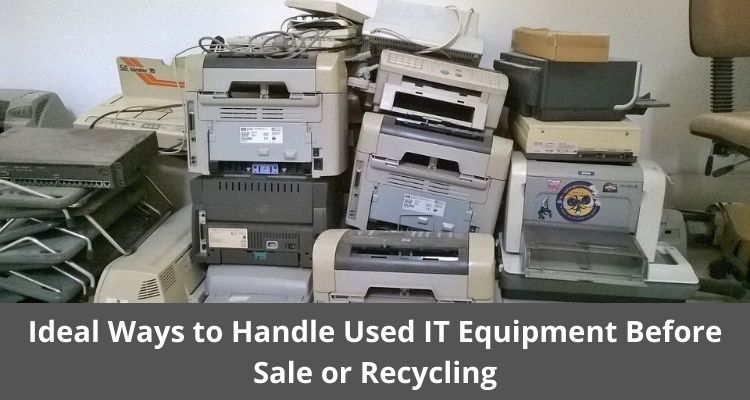
Ideal Ways to Handle Used IT Equipment Before Sale or Recycling
In the rapidly evolving landscape of technology, the need to responsibly handle used IT equipment has become more crucial than ever. Whether you’re preparing to sell or recycle your pre-owned devices, ensuring they are properly managed can lead to benefits for both your organization and the environment.
This guide will walk you through the ideal methods to handle used IT equipment, from data management and security to refurbishment and proper disposal.
By following these steps, you’ll not only optimize the value of your equipment but also contribute to a more sustainable and responsible approach to technology lifecycle management.
Data Management and Security
Backing Up Important Data
Backing up is necessary and one of the important steps. It involves creating duplicate copies of critical information stored on the equipment. It’s akin to making a safety net for important data. This ensures that if unexpected events occur, such as data loss during handling, the crucial information can be retrieved and restored.
Secure Data Wiping or Destruction
It addresses the secure disposal of data. It’s important to use methods that completely remove all traces of information from the device. This ensures that sensitive information cannot be retrieved, providing a level of security against unauthorized access.
Ensuring Compliance with Data Privacy Regulations
It emphasizes the importance of following legal and regulatory guidelines related to data privacy. Different regions and industries have specific rules about how data should be handled, especially during disposal. Adhering to these regulations is crucial to avoid legal consequences and uphold the ethical responsibility of safeguarding sensitive information.
Cleaning and Maintenance
Exterior Cleaning
This involves cleaning the outer surface of the equipment to remove dirt, dust, and any contaminants. This process helps to clean the equipment and make it ready to sell them to the vendor.
Interior Dusting and Ventilation
This involves cleaning the internal components of the equipment. Dusting helps remove accumulated dust and debris, which can affect the performance and lifespan of the equipment. Proper ventilation ensures that air can flow freely through the device, preventing overheating and maintaining optimal functionality.
Performing Basic Maintenance Checks
This involves conducting routine checks to ensure that all components are functioning as they should. It may include inspecting cables, connectors, fans, and other essential parts. Identifying and addressing any minor issues during this process can help prevent more significant problems in the future.
Documentation and Certification
Keeping Records of Preparations and Actions Taken
This involves maintaining detailed records of all the steps and actions taken during the process of handling used IT equipment. It includes documenting activities such as data backup, data wiping, refurbishment, and any other relevant preparations. These records serve as a comprehensive log of the process and can be valuable for future reference, compliance, and accountability.
Obtaining Certifications for Responsible Disposal (if recycling)
If you choose to recycle the IT equipment, it’s important to obtain certifications that attest to the responsible and environmentally friendly disposal of the equipment. These certifications may include documents or seals from recognized recycling programs or organizations. They serve as evidence that your organization is committed to sustainable practices and proper disposal methods.
Choosing the Recycling Partner
Researching Resale Platforms or Buyers
This step involves conducting thorough research to identify potential platforms, buyers, or markets where you can sell your used IT equipment. It’s important to explore options such as online marketplaces, IT equipment resellers, or potential buyers within your industry. Researching helps you understand the market demand, pricing trends, and the reputations of potential buyers.
Selecting a Reputable Recycling Facility or Partner
If you decide to recycle IT equipment, it’s crucial to choose a recycling facility or partner that is reputable and environmentally responsible. This involves evaluating recycling facilities based on their certifications, track record, and adherence to proper disposal practices. Selecting a reliable partner such as Telecom Recycle ensures that the equipment is recycled in an environmentally friendly and sustainable manner.
Proper Packaging and Transportation
Selecting Appropriate Packaging Materials
This step involves choosing the right materials to securely package the IT equipment. It’s important to use packaging materials that provide adequate protection against potential damage during transit. This may include items like sturdy boxes, bubble wrap, foam padding, anti-static bags (for sensitive electronic components), and secure tape. Proper packaging ensures that the equipment arrives at its destination in the same condition it left.
Ensuring Secure Transportation to the Buyer or Recycling Facility
Once the equipment is properly packaged, the next step is to ensure secure transportation. This involves taking precautions to prevent any potential accidents, mishandling, or theft during transit. Depending on the destination, you may need to arrange for a reliable courier service, freight carrier, or specialized logistics provider. It’s important to choose a transportation method that aligns with the size and fragility of the equipment.
Read Also: How to Choose an IT Asset Recycling & Disposition Services Provider? |
Why Choose Telecom Recycle for Used IT Equipment
Specialized Expertise: Telecom Recycle specializes in handling and recycling telecom and IT equipment. Their expertise in this field ensures that equipment is managed efficiently and in compliance with industry standards.
Environmentally Responsible: Telecom Recycle follows environmentally friendly practices in the disposal and recycling of IT equipment. This includes proper handling of hazardous materials and adherence to recycling and disposal regulations.
Data Security: They prioritize data security by offering secure data wiping or destruction services. This ensures that sensitive information is completely removed from the equipment, mitigating the risk of data breaches.
Compliance with Regulations: They are likely to be well-versed with industry-specific regulations and compliance standards for telecom and IT equipment, ensuring that all processes adhere to legal requirements.
Looking to sell your used telecom equipment? Telecom Recycle is the ideal place to get value from old telecom equipment. Call us at 1-888-900-7605 or send your details to bid@telecomrecycle.com.
